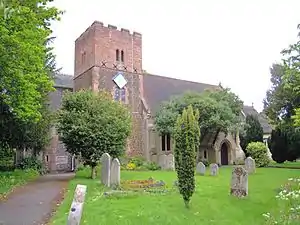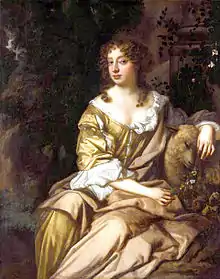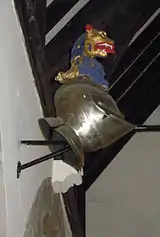Church of St Michael the Archangel, Aldershot
The Church of St Michael the Archangel is the parish church for the town of Aldershot in Hampshire. Dating to the 12th century with later additions, there was almost certainly an earlier church on the site. The existing structure is a Grade II listed building[1] and is located beside Manor Park.

History of St Michael's

The land on which St Michael's now stands was personally owned by Alfred the Great and when he died he left the land to the monks of Winchester Cathedral. The church was probably built sometime between 1120 and 1150.
The earliest mention of St Michael's church dates to 1121 and concerns wax for candles. The church is mentioned again in 1171 regarding an annual payment made by the parish of Aldershot to the Priory of St Swithun for the maintenance of three lights to burn continually before the High Altar there.[2]
In 1399 the parish priest, John Bertone, was severely attacked while officiating in the church. By 1400 the church was in a state of collapse and Bishop William of Wykeham sequestrated the Rectory of Crondall to pay for the necessary repairs. However, this seems to have achieved little because the church was reportedly still in a poor condition some 80 years later. In 1481 John Awbrey pledged 'My Manor at Aldershot' for a loan from the London Charterhouse of £126 in order to restore the church. He and his wife are buried in the chancel.[2]

The registers of baptisms, marriages and burials were first begun by William Shakford in 1571,[3] and are still in use. During the Civil War a curate of the parish, Thomas Hollinshead, was ejected in 1641. In 1645 during the same conflict, Royalist troops invaded the village of Aldershot and set fire to it but St Michael's was spared the fire and survived.
There is a local legend that, after the Restoration, Nell Gwyne, making a journey from Portsmouth to London in 1678, stopped over in the area where she gave birth to a stillborn child of Charles II, with medical help coming from 'Old Mother Squall' who lived near the church; the child was said to have been buried under a tree in the churchyard. It was claimed that for this assistance the King made an annual grant of £200 to the church, but no record of this has ever been found.[2]
The jurist Charles Viner (1678–1756) and his wife are buried in the churchyard and have a wall memorial in the church. The clock was installed in 1799 (as well as a turret bell) and in 1801 fear of body snatching resulted in the distinctive brick-arched graves in the churchyard. The Rev John West was a former vicar of the parish (1818-1820) and went on to become the missionary founder of the Church in Canada.[2][4]
In 1855, during the Crimean War, the Army came to Aldershot, which saw a major expansion not just in the town but also in St Michael's church. During this period the nearby Holy Trinity church was built to be nearer the Camp. From 1859 to 1912 St Michael's underwent a period of development and expansion, including the addition of an aisle, the rebuilding of the nave, and a new organ.[2]
Here in 1864 was baptised Edgar Sheldrake who went on to become a first-class cricketer.[5] Also here Alfred Toye VC married Flora Robertson in 1918. The marriage of local actor and comedian Arthur English to dancer Teresa Mann was held at the church in 1977, and in 1995 his funeral service was held there, following which he was cremated at the Park Crematorium in Aldershot.
Structure of the church

During the reign of Elizabeth I the tower was rebuilt and formed part of a chain of beacons to warn against the threatened invasion of the Spanish.[6] It is built from local 'galleted' iron stone with mortar and flints and dressings of narrow red bricks. There is a chancel, a nave of five bays, north aisle, and south porch. The nave was restored and the north aisle added in 1868, so that the tower, the chancel and the Lady Chapel extension of 1380 are the only ancient parts of the original church to survive.[2]
The chancel contains monuments dedicated to the local Whyte and Tichborne Family. There are also stained glass windows in memory of members of the Newcome family.
The Bells
The light eight were recast and rehung by John Taylor of Loughborough in early 1960. The first bell in the tower was hung in the late 14th century, with additional bells being added in 1611 and 1624. When the church was enlarged in 1911 the oldest bell was recast and three other bells added, making a ring of six. After World War I two trebles were donated by soldiers in Aldershot Camp in memory of their colleagues who had been killed in that conflict, and these are known as the 'Soldier's Bells'.[2]
Gallery
 The church from the road
The church from the road The altar in St Michael's
The altar in St Michael's Memorial to Lady Ellen Tichborne (1589–1606) the eldest daughter of Sir Robert White and first wife of Sir Richard Tichborne
Memorial to Lady Ellen Tichborne (1589–1606) the eldest daughter of Sir Robert White and first wife of Sir Richard Tichborne Memorial to Lady Mary Tichborne (d.1620) the younger daughter of Sir Robert White and wife of Sir Walter Tichborne
Memorial to Lady Mary Tichborne (d.1620) the younger daughter of Sir Robert White and wife of Sir Walter Tichborne The font in St Michael's
The font in St Michael's The Lady Chapel
The Lady Chapel
References
- Historic England. "Church of St Michael the Archangel (1339670)". National Heritage List for England. Retrieved 17 July 2014.
- History of St Michael's Church, Aldershot - Rushmoor Borough Council Website
- 'About Aldershot' - Kellys Directory of Hampshire (1898) - Aldershot Civic Society website
- Biography of Rev J.H. West in the Dictionary of Canadian Biography
- Edgar Francis Tolman Sheldrake in the England, Select Births and Christenings, 1538-1975
- St Michael's on the Church of England website